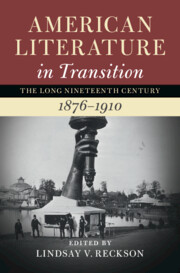Book contents
- American Literature in Transition, 1876–1910
- Nineteenth-Century American Literature in Transition
- American Literature in Transition, 1876–1910
- Copyright page
- Contents
- Contributors
- Series Preface
- Acknowledgments
- Chronology
- Introduction
- Part I Transitive States
- Chapter 1 Radical Pasts, Radical Futures
- Chapter 2 Unsettled Colonialisms
- Chapter 3 Secularism, Race, and Sex
- Chapter 4 Sex and the Suicide Plot
- Chapter 5 Virtual Subjects
- Part II Post-Reconstruction Aesthetics
- Part III Old Materialisms
- Part IV Immanent Techniques
- Index
Chapter 1 - Radical Pasts, Radical Futures
from Part I - Transitive States
Published online by Cambridge University Press: 24 August 2022
- American Literature in Transition, 1876–1910
- Nineteenth-Century American Literature in Transition
- American Literature in Transition, 1876–1910
- Copyright page
- Contents
- Contributors
- Series Preface
- Acknowledgments
- Chronology
- Introduction
- Part I Transitive States
- Chapter 1 Radical Pasts, Radical Futures
- Chapter 2 Unsettled Colonialisms
- Chapter 3 Secularism, Race, and Sex
- Chapter 4 Sex and the Suicide Plot
- Chapter 5 Virtual Subjects
- Part II Post-Reconstruction Aesthetics
- Part III Old Materialisms
- Part IV Immanent Techniques
- Index
Summary
The final decades of the nineteenth century were marked by unprecedented levels of labor unrest, agitation, and organization in the United States, a period most often remembered, if at all, by way of the Great Railroad Strike of 1877 and the Homestead Steel Strike of 1892, both of which were ultimately broken by the mobilization of state, federal, or private troops. The names of the 36,757 strikes that occurred across a variety of US industries between 1881 and 1905 – among them, the 1886 Collar Laundresses’ strike in Troy, New York, the 1891 Negro Laborers’ Union strike in Savannah, Georgia, and the 1896 Cloud City Miners’ Union strike in Leadville, Colorado – have largely been forgotten, taking with them not only any record of their successes in local pay disputes, securing the right to unionize, and increasing support for an eight-hour work day, but also the memory of the over six million American workers who participated in these various strike actions, whatever their individual outcomes.1 Yet for nineteenth-century Americans, this labor history was vividly present to mind, whatever one’s political persuasions. As William Dean Howells pointedly highlights in his 1890 novel, A Hazard of New Fortunes, strikes were part of the fabric of everyday late nineteenth-century American life, particularly for the ever-increasing number of US urban dwellers, and they were experienced both as scenes of ferocious violence – a policeman indiscriminately clubbing striking streetcar workers, with a face “not bad, not cruel … a mere image of irresponsible and involuntary authority” – and as fodder for sensational newspaper stories and regular conversation, even for those “not personally incommoded” by them.2 And the increasing militancy of US labor in the post-Reconstruction moment came hand in hand with the search for radical alternatives to the period’s ongoing economic instability, waves of unemployment, poor working conditions, and ever greater concentration of wealth into fewer and fewer hands – which is to say, to capitalism as they then knew and lived it.3
- Type
- Chapter
- Information
- American Literature in Transition, 1876–1910 , pp. 17 - 37Publisher: Cambridge University PressPrint publication year: 2022



